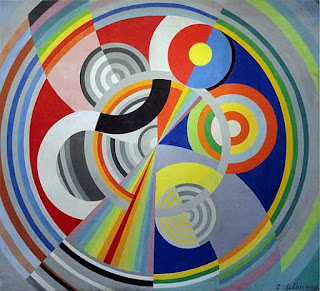In admiration of Robert Delaunay.
Robert Delaunay is one of the pioneers of abstract painting. He left us with various fine artworks, and I love them.
I'll make some creative coding artwork with the inspiration of the paintings by Robert Delaunay.
Put some arcs randomly on concentric circles.
At first, I draw some concentric circles with various shades of grey.
Then, I draw some arcs randomly like this.
Here is the result example. I applied transparency on these arcs.
Here is the example drawing with the 'blendMode(BURN)' effect.
p5.js example code
/**
* In admiration of Robert Delaunay.
* Put arcs randonly
*
* @author @deconbatch
* @version 0.1
* @license CC0
* p5.js 1.5.0
* created 2023.02.15
*/
const w = 640;
const h = w;
const circleNum = 9;
const arcNum = 8;
const baseR = w * 1.3;
function setup() {
createCanvas(w, h);
colorMode(HSB, 360, 100, 100, 100);
noLoop();
}
function draw() {
translate(w * 0.5, h * 0.5);
blendMode(BLEND);
background(0, 0, 100, 100);
// concentric circles
blendMode(BLEND);
noStroke();
for (let cCnt = 0; cCnt < circleNum; cCnt++) {
fill(0, 0, random(60, 80), random(60));
circle(0, 0, baseR * (circleNum - cCnt) / circleNum);
}
// arcs
blendMode(BURN);
noFill();
strokeCap(SQUARE);
for (let aCnt = 0; aCnt < arcNum; aCnt++) {
let arcR = random(baseR);
let arcW = random(baseR);
let tFr = random(TWO_PI);
let tTo = tFr + random(PI);
strokeWeight(arcW);
stroke(random(360), 40, random(60, 80), random(60, 100));
arc(
0.0, 0.0,
arcR + arcW, arcR + arcW,
tFr, tTo
);
}
}
function mouseClicked() {
redraw();
}
I drew arcs with the 'arc()' function. I did not use 'fill()' but 'stroke()', that is, I drew arcs with a bold line.
'strokeCap(SQUARE)' is the point to draw a nice arc.
If you use the 'strokeCap(PROJECT)' function, you'll see it will stick out a little.
Without the 'strokeCap()' function or with the 'strokeCap(ROUND)' will be like this.
But it looks something nice.
Control the disposition.
In the example code above, each of the radii, widths, and angles of the arcs is random. And the result looks rough. It does not capture my heart.
So, I'll try to set the unit of the radii and width of the arc to the radii unit of the concentric circles.
// let arcR = random(baseR);
// let arcW = random(baseR);
let arcR = baseR * floor(random(1, circleNum)) / circleNum;
let arcW = baseR * floor(random(1, circleNum)) / circleNum;
Then, I'll try to set the unit of the angle of the arc to some fixed value like 24-division.
// let tFr = random(TWO_PI);
// let tTo = tFr + random(PI);
let tFr = TWO_PI * floor(random(24)) / 24;
let tTo = tFr + PI * floor(random(1, 13)) / 12;
It'll create a smooth result.
Now, I'll show you the example codes of the p5.js and the Processing version.
p5.js example code
/**
* In admiration of Robert Delaunay.
* Fixed unit arcs
*
* @author @deconbatch
* @version 0.1
* @license CC0
* p5.js 1.5.0
* created 2023.02.15
*/
const w = 640;
const h = w;
const circleNum = 9;
const arcNum = 8;
const baseR = w * 1.3;
function setup() {
createCanvas(w, h);
colorMode(HSB, 360, 100, 100, 100);
noLoop();
}
function draw() {
translate(w * 0.5, h * 0.5);
blendMode(BLEND);
background(0, 0, 100, 100);
// concentric circles
blendMode(BLEND);
noStroke();
for (let cCnt = 0; cCnt < circleNum; cCnt++) {
fill(0, 0, random(60, 80), random(60));
circle(0, 0, baseR * (circleNum - cCnt) / circleNum);
}
// arcs
blendMode(BURN);
noFill();
strokeCap(SQUARE);
for (let aCnt = 0; aCnt < arcNum; aCnt++) {
let arcR = baseR * floor(random(1, circleNum)) / circleNum;
let arcW = baseR * floor(random(1, circleNum)) / circleNum;
let tFr = TWO_PI * floor(random(24)) / 24;
let tTo = tFr + PI * floor(random(1, 13)) / 12;
strokeWeight(arcW);
stroke(random(360), 40, random(60, 80), random(60, 100));
arc(
0.0, 0.0,
arcR + arcW, arcR + arcW,
tFr, tTo
);
}
}
function mouseClicked() {
redraw();
}
Processing example code
/**
* In admiration of Robert Delaunay.
* Fixed unit arcs
*
* @author @deconbatch
* @version 0.1
* @license CC0
* Processing 3.5.3
* created 2023.02.15
*/
public void setup() {
size(640, 640);
colorMode(HSB, 360.0, 100.0, 100.0, 100.0);
smooth();
noLoop();
int circleNum = 9;
int arcNum = 8;
float baseR = width * 1.3;
translate(width * 0.5, height * 0.5);
blendMode(BLEND);
background(0.0, 0.0, 100.0, 100.0);
// concentric circles
blendMode(BLEND);
noStroke();
for (int cCnt = 0; cCnt < circleNum; cCnt++) {
fill(0.0, 0.0, random(60.0, 80.0), random(60.0));
circle(0.0, 0.0, baseR * (circleNum - cCnt) * 1.0 / circleNum);
}
// arcs
blendMode(SUBTRACT);
noFill();
strokeCap(SQUARE);
for (int aCnt = 0; aCnt < arcNum; aCnt++) {
float arcR = baseR * floor(random(1, circleNum)) * 1.0 / circleNum;
float arcW = baseR * floor(random(1, circleNum)) * 1.0 / circleNum;
float tFr = TWO_PI * floor(random(24)) / 24.0;
float tTo = tFr + PI * floor(random(1, 13)) / 12.0;
strokeWeight(arcW);
stroke(random(360.0), 40.0, random(60.0, 80.0), random(60.0, 100.0));
arc(
0.0, 0.0,
arcR + arcW, arcR + arcW,
tFr, tTo
);
}
}
Room for creativity
I feel it may be good composition when the edge of the arcs is on the vertical, horizontal, or diagonal line.
There is room for a lot of fun and ingenuity in this code, such as controlling the composition or changing the way the hue is determined, which is random this time. Please have fun with my code if you like it.




















